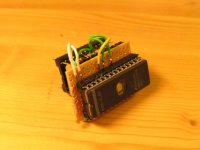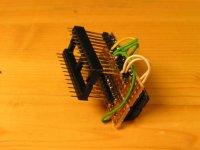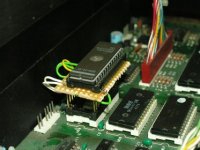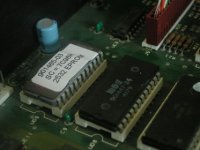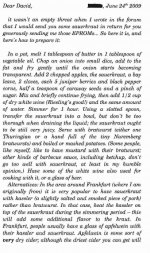Hi all,
here are some photos of the 27C64 adapter I built using a 24 and a 28 pin socket, wire-wrap connectors, some wire and a piece of veroboard:
Initially I tried the procedure described by Mike_S in
What I do is take a 28 pin socket and bend out the pins that will be rerouted; then I take a 24 pin socket and solder thin wirewrap wire to the pins that will need to be rerouted. Poke the 28 pin through a piece of paper to insulate the rerouted pins and plug it into the 24 pin.
but when stacking all these sockets directly on top of each other so that they seemed safely connected, there was hardly any gap left a wire could be routet through. (Maybe I partly misunderstood the directions?) The wire-wrap connectors allowed me to circumvent this problem, and bending out the pins which needed rerouting still did the trick.
Here's the adaptor plugged into the PET's motherboard:
It does indeed not look too pretty... To this end, though being very happy the PET is, in principle, working again, I would indeed prefer a less bulgy solution. Since I haven't managed to get in touch with Bacon, I'd love to fall back on Dave's kind offer to send me 2532 over from sunny California. (Dave, do you read?)
Alternatively I might once more dive into the "etch-your-own-PCB" business -- although I remember it to be a really messy business when I last tried it some 25 years agio... (I was etching a board that would allow you to plug a second SID into the C64, according to instructions published by the renowned German 64'er magazine

)
As for Nicolas' RAM/ROM expansion...
I did not follow the complete thread now but if you want to repair your PET 2001 Motherboard the best solution is this PET RAM/ROM Expansion from Nicolas Welte / Germany.
...I've encountered his hardware pages during my research regarding the PET's repair, and though the expansion board looks like a really smart device, it is somewhat beyond what I'd (currently) consider an appropriate modification for restoring a vintage computer's functionality. But that may change in future... ;-)
(BTW, the name Nicolas Welte somehow rang a bell -- is it possible that this guy has already been publishing Commodore-related stuff back in the eighteis? Books, magazines?)
So what's left to do?
- The keyboard definitely needs some cleaning. Some keys ceased to work at all -- for instance "CRSR Left/RIgh", which is pretty annoying.
- Currently the audio amplifier gets its supply voltage directly from the raw power supply connector (J8, it is?) -- which is probably the reason for the huge amount of continuously audible hissing and humming. I guess there must be some better way to drive the amplifier?
- After some minutes after powering on, the PET's screen starts to flicker vertically (not horizontally, as I initially stated by mistake). Don't know what to do about this yet, and I am admittedly not particularly keen on messing around with such a high voltage device as a video ciruit...
- Find a convenient way for transfering files between a PC and the PET. Reviewing
http://www.vintage-computer.com/vcforum/showthread.php?t=14878 should reveal something.
So... I guess this is it. Is there a way to mark this thread as SOLVED?

Regards --


